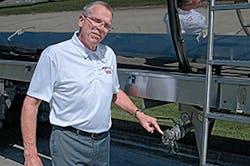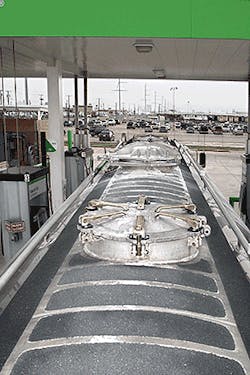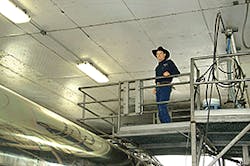Recent moves suggest OSHA is taking a renewed look at fall risks on cargo tanks
FALL protection for cargo tanks may become a more complicated issue for the tank truck industry. That was one of the conclusions coming out of the Fall General Meeting of the Cargo Tank Risk Management Committee (CTRMC) held in mid-September near Washington DC’s Dulles Airport.
Tank truck carrier, shipper and tank equipment supplier representatives addressed topics ranging from recent OSHA rulings to industry efforts to eliminate workers from going on top of tank trailers, to safety concerns of a panel of tank truck drivers. The meeting was co-hosted by the Truck Trailer Manufacturers Association (TTMA) and National Tank Truck Carriers Inc (NTTC).
Dr Nigel Ellis of Ellis Fall Solutions reported that the Occupational Safety and Health Administration (OSHA) has “archived” its March 10, 2004 interpretation which has been relied upon as a defense by the trucking industry in cases involving falls from trailers. In that 2004 letter, OSHA said that the 29CFR 1926.501(b)(1) duty of an employer to provide fall protection did not include “ladders, vehicles or trailers, on which employees must be located in order to perform their duties” and that the General Duty Clause did not exist “where there is no feasible means of providing it,” including on trailers. The OSHA Archive notice means that the document “no longer represents OSHA policy.” OSHA issued the archive letter on August 20, 2015.
While there is currently a “Memorandum of Under-standing” (MOU) dating back to the 1970s between OSHA and the Department of Transportation that OSHA will not regulate trucking equipment in service, OSHA has shown its interest in moving into that area currently considered under DOT jurisdiction. In its extensive Notice of Proposed Rulemaking on Fall Protection (docket number OSHA-2007-0072-0001), OSHA asked eight questions, including: “Should OSHA exclude rolling stock from coverage under subpart D?”
(See the CTRMC response in the sidebar.)
Stay off tanks
CTRMC’s ongoing efforts to eliminate or significantly reduce the need for drivers and workers to go on top of tank trailers were addressed by several speakers. One approach is to eliminate cleanout caps on trailers, what one attendee called “the least engineered part of a tank trailer.” CTRMC advocates removing cleanout caps from the more than 25,000 chemical tank trailers now in service, as well as on new trailers. Trailer manufacturers in attendance said that they now let customers know that they have the option of ordering trailers without cleanup caps, though the majority of carriers still specify them—as they have always been “standard.”
The transition to trailers without cleanouts at the ends of the trailers will not happen overnight, and efforts must continue to make access to those caps safe and infrequent. One concern expressed by a number of carriers is that many shippers make the driver move the tank trailer off shipper property after loading to secure equipment on top of the tank, rather than allow them to do it on site where there is a loading rack. While many shippers have stated that they do not require drivers to first exit their property, carrier representatives and members of the driver panel said this remains a common practice.
Both carrier safety directors and drivers said that problems arise because the wrong cleaning caps are put back on a tanker after cleaning, or the trailer is dispatched with improper fitting or poorly maintained caps. Closing the caps too hard after cleaning can strip threads, and be as much a source of leaks as not closing the caps tight enough. This especially is a problem with intermodal containers from overseas. (See the CTRMC White Paper on eliminating cleanouts.)
Other topics that attendees agreed to explore were how to eliminate damage to tank trailers during transloading from railcars, how elimination of cleanouts and other openings can reduce the need for security seals, improvements to “catwalks” and ladders for when workers must go on top of trailers, and cleaning approaches with tankcars that might be adapted to tank trucks.
CTRMC will continue to work with tank cleaning equipment suppliers to develop systems that will clean the entire tank without the need for cleanouts at trailer ends. The group also will work to improve and implement VISION 2020 in trailers to incorporate more safety in tank trailers. Several trailers incorporating VISION 2020 ideas for cleaning and fall protection will be on display at Tank Truck Week hosted by National Tank Truck Carriers, November 11-13 in Houston. http://www.tanktruck.org/meetings/tank-truck-week-2015/
VISION 2020 is available as TTMA Recommended Practice 105 at www.ttmanet.org.
Driver panel
One of the most popular features of recent CTRMC meetings has been the tank truck driver panel. Drivers are encouraged to take part in all discussions, as well as during their own presentations. Here are some of the issues and comments from the September Driver Panel:
• Drivers appreciate all training but would like to have more training in areas of pumping and safe product transfer. They do receive good information on safe driving, hours of service, etc, but more education on product, fall protection, and conditions at new loading/delivery sites would be beneficial. Also, more information and resources for “onboarding” new drivers would help.
• Drivers would like to not have to go on top of tanks, but there are many reasons they have to for product quality and securement reasons. It is especially frustrating when they are told to exit the shipper property before securing tanks after loading. Additional training on safe access to tank tops and better ladders is needed, especially when the need to carry equipment makes “three-point climbing” difficult. Even “3-o’clock” locations of catwalks are better than going on top of the tank, especially as drivers get older.
• Drivers would like more information on the company they work for, including plans and the type of information any other employee finds beneficial. “Drive-alongs” with company executives, dispatchers, and others are welcome. This might help educate others on the need for specifying the right trailer—rear or side-unloading—and better information about delivery sites for safer and more efficient deliveries. Top management should visit cleaning facilities.
• While “sitting and waiting” is part of a driver’s job at shipper or consignee facilities and cleaning racks in the tank truck industry, efforts could be made to reduce the stress of waiting. Some shippers will tell a driver to turn off his engine and remain in the truck. This is especially difficult and tiring on hot days. Quality of life improvements could help with driver attraction and retention.
• More standardization in the tank cleaning industry could help reduce problems with loose or missing cleaning caps. Cleaning facilities also should ensure that water is removed from vapor recovery and other lines. More use of customer hoses and pumps would eliminate some problems. Mounting air hose connections at the fender rather than the top of tank would reduce the need to climb.
• Drivers do recognize when another driver is having problems that could lead to a rollover, crash, or product mishandling. However, there is a natural reluctance to tell someone in authority that a driver might need a few days off or other duty. More drivers would be willing to pass on concerns to management if there was a confidential way to do so that would result in help for the driver.
• Advances in electronics and onboard devices have been a positive development, but also can lead to stress, especially in the area of hours of service. Shippers need to be better educated about hours of service compliance and understand that if a driver is delayed past his allotted hours by the shipper, he cannot leave the property without violating the law.
• While truck driving is a tougher job today due to congestion, distracted motorists, and shipper requirements, it is still a good job, especially at a company with good communications policies. It is important when trying to attract new drivers to the industry to point out driving is a lifestyle, not a job. Recruitment will be easier when drivers are treated with more respect by their companies, customers and law enforcement.
• Remember the driver’s family and what they have to do while the driver is on the road. Consider the driver’s family a key element in how he does his job.
The next CTRMC General Meeting will be held March 16, 2016 in St Louis, Missouri, and will be hosted by Archer-Daniels- Midland (ADM). CTRMC meetings are open to any tank truck industry stakeholders interested in safety.
For more information on CTRMC safety efforts and resources, visit http://www.cargotanksafety.org/
Retired president of National Tank Truck Carriers, John Conley can be reached at ConleyComm LLC, [email protected] ♦
About the Author
John Conley
President
John Conley established ConleyComm LLC where he develops written and oral communications on trucking and hazardous materials industry and regulatory issues. He also is a member of trucking industry safety groups.
John is Past President of National Tank Truck Carriers, the trade association that represents more than 200 highway transporters of commodities in bulk as well as nearly 300 suppliers to that industry. He retired from NTTC in December 2013. He joined NTTC in 1989 after serving as editor of Modern Bulk Transporter magazine for 12 years. He is a past member of the Board of the Dangerous Goods Advisory Council, the Transportation Research Board’s Committee on the Transportation of Hazardous Materials, and the Commercial Vehicle Safety Alliance Hazardous Materials Committee. He also served on the TRANSCAER National Steering Committee. Conley holds a Masters Degree in Journalism from the University of Maryland and is a veteran of the U. S. Navy. He is currently writing a book on the history of the tank truck industry.



